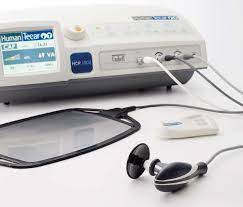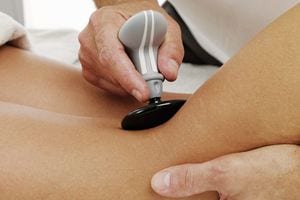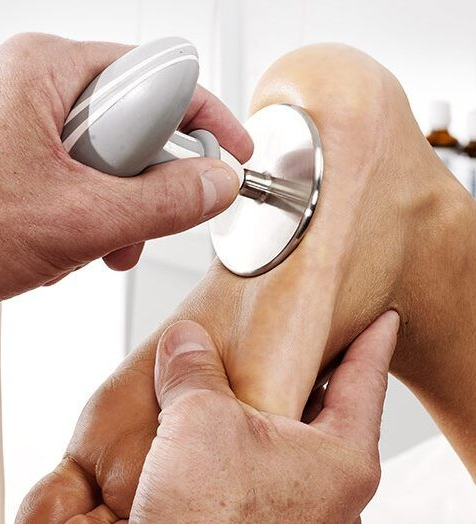What is TECAR Therapy?
By Dawn Morse MSc
An introduction to TECAR therapy and use within clinical injury treatment:
TECAR stands for the Spanish acronym Tranferencia Electica Capacitiva Resistiva, meaning Capacitive Resistive Electric Transference. This modality is sometimes also referred to as, Capacitive and Resistive Electric Transfer Therapy.
The modality itself was founded in Milan about 35 years ago and was originally designed for professional athletes.
Tecar therapy provides deep tissue thermotherapy (diathermy) which increases the body’s natural biological reactions, local tissue temperature and blood flow. The endogenous heat and increased localised circulation are used to treat a wide range of musculoskeletal and bony disorders due to its ability to increase circulation within all of the body’s tissues, to reduce muscle contractures, whilst increasing elasticity within the soft tissue and providing an analgesic effect.
A key feature of Tecar therapy compared to other electrotherapy devices is that it stimulates an internal reaction which leads to the increase in circulation from the inside out. This is achieved by the Tecar current being stimulated between two electrodes. The capacitive or resistive electrodes create a circuit to deliver therapeutic effects with objectives of, reducing pain, reducing musculoskeletal dysfunction, or decreased oedema.

When in contact with biological tissue, the closed circuit between the electrode and a return plate, triggers metabolic activation of the tissue, stimulating blood flow and lymphatic flow within the targeted areas to achieve treatment aims.
All tissues between the electrode and the return plate are stimulated and the intensity of the current can be manipulated depending on the size of the circuit / treatment area.
Three Key Therapeutic Reactions:
Biological – boosts cellular metabolism through increased permeability
Analgesic – provides pain relief through nociceptor saturation
Diathermy – stimulates superficial and deep heat which produces long lasting warmth within the tissue.
Diathermy leads to:
Increased tissue oxygenation
Reduces tissue tension
Increased vascularisation and drainage
Stimulates collagen creation


These biological reactions lead to:
Reduced Pain – inhibits pain immediately for a duration of more than 48 hours after treatment.
Increased Movement – relieves soft tissue tension through health and increased blood flow. ROM immediately restored.
Accelerated Healing – accelerates the body’s natural self-healing system by promoting intra and extracellular exchanges in a lasting way. Healing is stimulated in all of the body’s tissues including bony tissue.
A Hands-On Modality:
Tecar is still considered a hands-on treatment as electrodes are held within the hand and application is applied though massage type movements.
Within treatment two different electrode frequencies can be used to target different tissues. Capacitive, high impedance electrodes target soft tissue with higher water content, including the dermis, lymphatic system, venous system and muscle tissue.
Whereas, Resistive, low impedance electrodes target tissue with the highest electrical resistance such as joints, tendons, ligaments, cartilage and bone.
Can treat many injuries and wider conditions:
With the ability to target a wide range of tissue, Tecar therapy can be used to treat many injuries and wider conditions such as, but not limited to:
Hematoma and, or inflammation
Arthritis pain, Fractures, Cellulitis
Diabetic Ulcer, Tendon injury, Ligament injury
Soft tissue injury and spasm
Trigger point tension
Scar Tissue
Lymphatic drainage
Cellulite (can be used for aesthetics treatment including cellulite reduction and collegen stimulation)
With these conditions in mind, Tecar can be used for a range of applications such as:
Reducing recovery time from training and competition and enhancing sports performance.
Treating a wide range of soft tissue and bony injuries.
Reducing recovery time from acute and chronic injury, aids scar adhesion, reduces oedema and pain.
Plus, Tecar can be used within aesthetic treatment and for collagen synthesis too.
Overall Tecar therapy is a fantastic modality for clinical treatment, and is becoming increasingly popular within the UK, whilst it’s use is already widspread across Eurpoe and further afield.
By Dawn Morse BSc, PGCE, MSc,
Dawn is a sports science and therapy lecturer and the director of Core Elements Training. Core Elements Training offers a range of accredited qualifications and short courses, including Level 3 & 4 Sports and Remedial massage therapy, Level 5 Diploma in Sports and Clinical Therapy and CPD short courses such as: Introduction to TECAR therapy, Dry Cupping, Dry Needling, Manual Therapy, Electrotherapy and Rehabilitation.
To find out more about Core Elements accredited CPD short course in TECAR therapy please visit the course page by Clicking Here.

